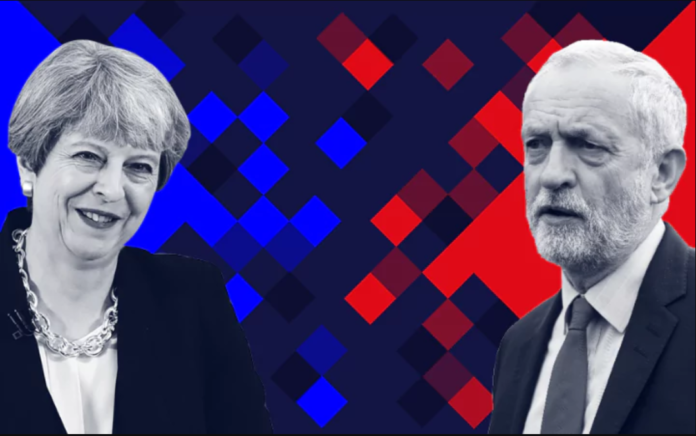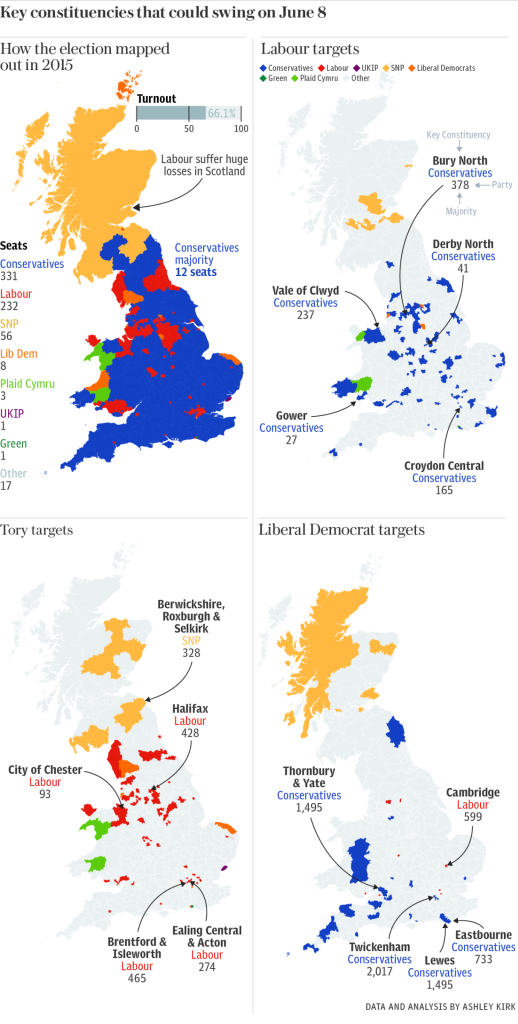
The final general election polls – all published before polling booths open – have given a last minute boost to the Conservatives, after a Labour surge that saw the gap close dramatically.
Even YouGov, who have tended to estimate higher Labour support than most pollsters, recorded a three point drop for Jeremy Corbyn’s party in their final poll.
The campaign has been marked by two terror attacks at London Bridge and Manchester, but neither even seems to have had an impact on the polling.
The gap between the two major parties has narrowed in our poll tracker since the campaign began, however there is still a healthy deficit still left to overcome.
Theresa May’s Conservatives end with an average of 43 per cent in our poll tracker, while Labour sit on 36.5 per cent.
According to the latest forecast by the University of East Anglia’s Chris Hanretty, the Conservatives would still gain a strong majority in Parliament.
Thanks to seat gains in the North of England and Scotland, Theresa May would benefit from a swing of 45 seats and end up with 375 MPs in Parliament.
Election polls show Tory decline
At the start of the campaign some polls had the Tories at almost double the vote share of the Labour Party, indicating that the most likely outcome would be a landslide victory that would increase Theresa May’s current working majority of 17 in the House of Commons.
However, May’s lead has dropped from 17.8 points to below seven in our poll tracker since she called the election on April 18. This is a rolling daily average of the last eight polls.
While the pollsters still give the Tories a clear lead, the the party’s dwindling advantage will be a concern to party headquarters, and a boost to their rivals.
Some experts had estimated that the Tories would take as many as 56 seats from Labour, leaving them with a 200-seat lead over the official opposition party, aided by Ukip’s apparent collapse in popular support over recent weeks.
A healthy Tory majority is still on the cards, but Labour now look set to win more of the vote than they did under Ed Miliband in 2015.
If the race continues to tighten in the remaining days and the poll results are replicated on election day, Theresa May could be on course for a much smaller majority than anticipated.
Follow how the race is shaping up with The Telegraph‘s poll tracker, which looks at national voting intention from individual polls.
What are the betting odds for the UK general election?
Political pollsters have taken a beating recently after failing to predict a Conservative majority in 2015, a Leave vote last summer and a Donald Trump victory in November.
For those who have lost faith in polling, there is another way of predicting electoral outcomes: ask people who are prepared to put their money where their mouth is. Many now believe that political betting markets can better predict elections, relying on the wisdom of a crowd of punters to sort and weigh all the probabilities.
Coral’s latest odds for the election have Mrs May as most likely to continue as Prime Minister after the election. The latest odds for the party to emerge with the most seats are:
What are the key battlegrounds?
The Conservatives are likely to gain a series of key target seats in the General Election, capitalising on their strong position in the polls.
An analysis of the 2015 general election results by The Telegraph has shown that around 58 seats in Labour’s North and Midlands heartlands are under threat due to the Brexit effect in the upcoming snap election on June 8.
There are 58 Labour-held seats where the Conservatives are fewer than 9,000 votes behind and where the constituents voted Leave in the EU referendum last June – 37 of which are located in the Midlands or in the North of England.
The seat with the narrowest Labour majority is Halifax where the Conservatives finished just 428 votes behind Labour in the 2015 general election. This seat is particularly vulnerable due to the fact that Halifax voted to Leave the EU by 60 per cent.
The Tories will, however, face pressure from enthusiastic EU-backing Lib Dems who will seek to regain seats that they lost in the 2015 general election.
Mrs May currently holds Remain-backing Lewes with a majority of 1,083 (2.1 per cent) and Twickenham with a majority of 2,017 (3.3 per cent). Both of these were taken from the Lib Dems by David Cameron in 2015, and Tim Farron’s pro-EU party will be seeking to win them back.
Who is voting for which party?
Class is no longer the dividing line in British politics with the Conservatives attracting considerable support from working-class voters according to recent polling.
Some 43 per cent of C2DE voters – which includes skilled and unskilled manual labourers, casual workers and pensioners – said they intend to vote Tory in the upcoming General Election, rising just three points among ABC1 voters, who include managerial, administrative or professional workers.
The Labour Party has sunk to attracting just 24 per cent of middle class and 26 per cent of working class voters.
If you want to find the new dividing line in British politics, age is the new predictor. Generally, YouGov’s polling has found that the older you get, the more likely you are to vote Conservative.
Labour is 19 points ahead among 18-24 year-olds while the Conservatives are ahead by a huge 49 points among the over 65s.



























Fingers crossed:.)))))))))))))))))
Who will win the election????